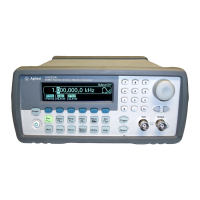
 Loading...
Loading...
Do you have a question about the Agilent Technologies 33220A and is the answer not in the manual?
| Function Generator Type | Arbitrary Waveform Generator |
|---|---|
| Output Amplitude | 10 mVpp to 10 Vpp into 50 Ω |
| Output Impedance | 50 Ω |
| Waveforms | Sine, Square, Ramp, Triangle, Noise, Arbitrary |
| Interface | GPIB, USB |
| Power Requirements | 100 to 240 VAC, 50/60 Hz |
Check the list of supplied items and connect the power cord and turn on the function generator.
Steps to change the output frequency to 1.2 MHz using the front panel controls.
Instructions for mounting the Agilent 33220A in a standard 19-inch rack cabinet.
Overview of the front-panel menus and examples of their use.
Setting the output termination impedance for accurate amplitude and offset measurements.
Setting up GPIB, USB, and LAN interfaces for remote instrument control.
Information on configuring the function generator for outputting various waveforms.
Details on setting up and performing amplitude modulation.
Introduction to calibration features and security settings.
Overview of SCPI command syntax and conventions.
Low-level SCPI commands for controlling output functions.
Commands for configuring GPIB, LAN, and USB interfaces.
List and explanation of errors related to command syntax and parameters.
List and explanation of errors resulting from incorrect command execution or settings.
Errors indicating potential hardware failures or memory corruption.
Overview of example programs for controlling the instrument via SCPI.
Includes examples like Sine Waveform, Amplitude Modulation, and Pulse Width Modulation.
Explanation of the DDS signal generation technique used by the instrument.
Guide on creating custom waveforms using the front panel or software.
Description of harmonic, non-harmonic, and phase noise imperfections in signals.
Lists standard and built-in arbitrary waveform types.
Details general specifications like frequency accuracy and amplitude range.
Provides physical dimensions for benchtop and rack-mount configurations.